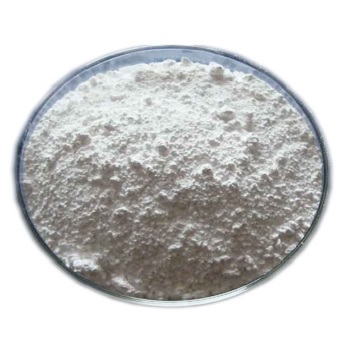|
| | Calcium phosphate Basic information |
| | Calcium phosphate Chemical Properties |
| Melting point | 1670°C | | density | 3.14 | | refractive index | 1.63 | | FEMA | 3081 | TRICALCIUM PHOSPHATE | | storage temp. | room temp | | solubility | Practically insoluble in water. It dissolves in dilute hydrochloric acid and in dilute nitric acid. | | form | aqueous suspension | | color | White | | PH | 6-8 (50g/l, H2O, 20°C) suspension | | Odor | Odorless | | Water Solubility | 0.1 g/L (25 ºC) | | Merck | 13,1699 | | Solubility Product Constant (Ksp) | pKsp: 28.68 | | InChIKey | QORWJWZARLRLPR-UHFFFAOYSA-H | | LogP | -2.15 | | CAS DataBase Reference | 7758-87-4(CAS DataBase Reference) | | EPA Substance Registry System | Tricalcium phosphate (7758-87-4) |
| | Calcium phosphate Usage And Synthesis |
| Description | Calcium Phosphate is the calcium salt of phosphoric acid with widely used applications. It occur abundantly in nature in several forms and are the principal minerals for the production of phosphate fertilizers and for a range of phosphorus compounds. For example, the tribasic variety (precipitated calcium phosphate), Ca3(PO4)2, is the principal inorganic constituent of bone ash. The acid salt Ca(H2PO4)2, produced by treating mineral phosphates with sulfuric acid, is employed as a plant food and stabilizer for plastics. It is a natural constituent of mammals, and it is a component of bone replacement transplants in much higher amounts with no toxicological problems.

Calcium phosphates are the largest group of artificial bone graft substitutes. This is mainly due to their close resemblance to the mineral components of bone. This Product can be used as a countermeasure for exposure to strontium and radium radionuclides. Upon oral uptake, calcium phosphate competes for and blocks the absorption of radium (Ra-226) and strontium (Sr-90) in the gastrointestinal (GI) tract.
| | Chemical Properties | White or almost white powder. | | Chemical Properties | Tricalcium phosphate is white solid, insoluble in water; reactive with silicon oxide and carbon at electric furnace temperature yielding phosphorus vapor; reactive with H2SO4 to form, according to the proportions used, phosphoric acid, or dicalcium hydrogen phosphate, CaHPO4, white solid, insoluble; or calcium dihydrogen phosphate, Ca(H2PO4)2·H2O, white solid, soluble. pKsp = 28.70. | | Physical properties | White amorphous powder; refractive index 1.63; density 3.14 g/cm3; melts at 1,670°C; insoluble in water; KSP 1.0x10-25; soluble in acids. | | Occurrence | Tribasic calcium phosphate occurs in nature as minerals, oxydapatite, whitlockite, voelicherite, apatite, phosphorite. It has many industrial applica tions. Some are similar to the monobasic and dibasic salts. It is used in fertil izers, dental products, ceramics and polishing powder. Some other important applications are in plastics as a stabilizer; as an anticaking agent; as a nutri ent supplement in cattle food; for clarifying sugar syrup; as a mordant in dye ing textiles; and as a buffer to control pH. | | Uses | Calcium Phosphate is a compound existing in several forms which
include the monobasic, dibasic, and tribasic forms of calcium phos-
phate. as calcium phosphate monobasic, also termed monocalcium
phosphate, calcium biphosphate, and acid calcium phosphate, it is
used as a leavening agent and acidulant. calcium phosphate diba-
sic, also termed dicalcium phosphate dihydrate, is used as a dough
conditioner and mineral supplement. calcium phosphate tribasic,
also termed tricalcium phosphate and precipitated calcium phos-
phate, is used as an anticaking agent, mineral supplement, and con-
ditioning agent. | | Uses | Calcium Phosphate is an anticaking agent and calcium source that is a white powder that is almost insoluble in water. It is used as an anticaking agent in table salt and dry vinegar. It is used as a source of calcium and phosphorus in cereals and desserts. It functions as a bleaching agent in flour and in lard, and prevents undesirable coloring and improves stability for frying. It is also termed tribasic calcium phosphate, tricalcium orthophosphate, calcium phosphate tribasic, and precipitated calcium phosphate. | | Uses | manufacture of fertilizers, H3PO4 and P Compounds; manufacture of milk-glass, polishing and dental powders, porcelains, pottery; enameling; clarifying sugar syrups; in animal feeds; as noncaking agent; in the textile industry. | | Uses | Tribasic calcium phosphate occurs in nature as minerals, oxydapatite, whitlockite, voelicherite, apatite, phosphorite. It has many industrial applications. Some are similar to the monobasic and dibasic salts. It is used in fertilizers, dental products, ceramics and polishing powder. Some other important applications are in plastics as a stabilizer; as an anticaking agent; as a nutrient supplement in cattle food; for clarifying sugar syrup; as a mordant in dyeing textiles; and as a buffer to control pH.
| | Preparation | Tribasic calcium phosphate is obtained from naturally occurring minerals for fertilizer applications. The compound may be prepared in the laboratory by the reaction of sodium phosphate with calcium chloride with excess of ammonia. Also, it can be prepared by treatment of calcium hydroxide with phosphoric acid:
2H3PO4 + 3Ca(OH)2 → Ca3(PO4)2 + 6H2O
| | Definition | ChEBI: Tricalcium bis(phosphate) is a calcium phosphate. | | General Description | β-tri-Calcium phosphate belongs to the category of calcium-phosphate based ceramics, which has been involved in the preparation of a new biosynthetic material possessing morphogenetic activity that is used as a bone implant. | | Flammability and Explosibility | Nonflammable | | Industrial uses | Calcium phosphate [Ca3(PO4)2] finds applications as a supplement for animal feed, as a fertiliser, in the manufacture of glass and in dental products. |
| | Calcium phosphate Preparation Products And Raw materials |
|



